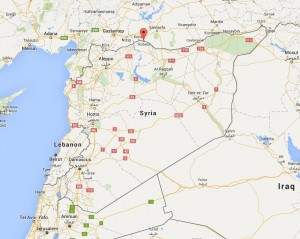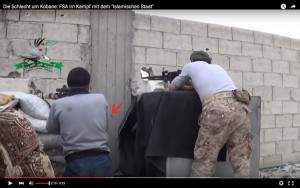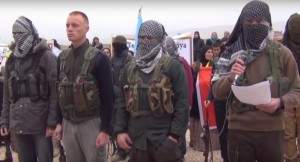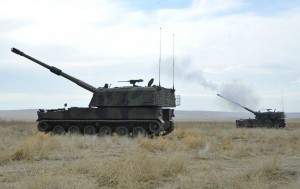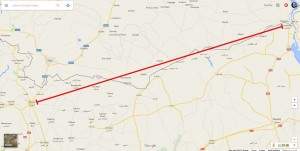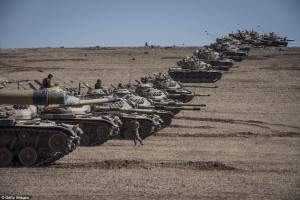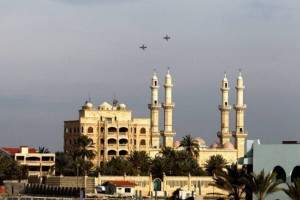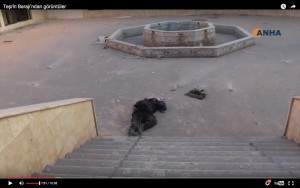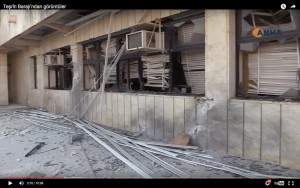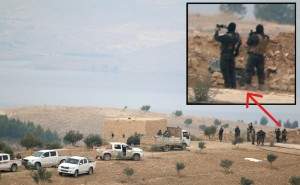Posturing staves off disaster in the Middle East
February 3, 2024 by Thomas Wictor
One of the reasons that westerners can’t solve the problems in the Middle East is that we can’t distinguish between genuine threats and posturing. I admit that I myself have this deficit. It’s not possible for me to tell what’s real and what’s a performance. However, Middle Easterners understand what’s actually going on. There’s always a reason for why they do things.
Until October of 2014, westerners hadn’t paid much attention to the Syrian Kurdish Peoples’ Protection Units (YPG), the militia of the Democratic Union Party (PYD). The PYD is the Syrian wing of the Kurdish Democratic Workers’ Party (PKK), a separatist organization at war with the government of Turkey. NATO and the US list the PKK as a terrorist group. Since 1984, over 40,000 people have been killed in the conflict between the PKK and the Turkish government. Of this total, about 6600 were Turkish security forces and 29,000 were PKK fighters.
Westerners are now aware of the YPG because of the Siege of Kobane (September 13, 2023 to March 15, 2024).
The official story is that about 1500 fighters of the YPG and YPJ (Women’s Protection Units) were joined by the Free Syrian Army and 150 Iraqi Peshmerga; with the help of American air strikes, this small group defeated about 10,000 Islamic State terrorists armed with up to fifty main battle tanks, hundreds of armored vehicles, heavy artillery, and vehicle-borne improvised explosive devices (VBIEDs) or truck bombs.
Well, once again the press failed to do its job. This is what I originally read.
Turkish President Recep Tayyip Erdogan said Friday that 1,300 Free Syrian Army fighters would join Kurds in defending the key Syrian border town of Kobane from an assault by Islamic State of Iraq and Syria militants.
The Syrian Kurds have “accepted 1,300 people from the Free Syrian Army (FSA) and they are holding talks to determine the transit route,” Erdogan told reporters in Estonia’s capital Tallinn.
Other sources said that it was 1500 FSA fighters. For some reason they were in Turkey, not Syria.
The Britain-based Syrian Observatory for Human Rights, confirmed the information but put the number at 50 fighters.
The pro-Kurdish Firat news agency said the FSA fighters had crossed in eight vehicles at the Mursitpinar border crossing.
Here’s a video of the FSA in Kobane. Note that one talkative, posturing guy with a beard is in control of every scene.
Did these fifty guys really contribute to the defeat of the Islamic State? A sniper sets himself up right next to the talkative, posturing leader, who’s firing a PKM light machine gun. Every shot ejects a spent casing that hits the sniper.
Spent casings are dangerous. This is what happens if they fall down your shirt and into your pants.
The Kurdish YPG is a conscript army, and its members serve only six months. This isn’t enough time to acquire the skills needed to carry out successful military operations on urban terrain (MOUT). Only a few hundred veterans of the Kurdish PKK have joined the YPG. However, these fighters are not experienced in MOUT.
I think the YPG has been getting help from professional warriors since October of 2014 at the latest. If Arab League special operators have been fighting in Syria for that long, it means that the planning is far more sophisticated than I realized.
Posturing? I hope so
Recently the YPG made what seemed to be an insane move.
Westerners fighting alongside Kurdish militants have urged other foreigners sympathetic to their struggle to carry out attacks against Turkey in an online video that threatens to complicate upcoming peace talks on Syria.
An English-speaking man with the face covered by a scarf is seen delivering the international call to arms in a six-minute clip titled Revolutionaries! Join the Resistance of Bakur! – a reference to Kurdish areas in south-eastern Turkey.
“We call on all revolutionaries worldwide – join the resistance. This is not the time to sit at home and ponder what might be,” he says, reading from a written statement, while standing with a Kalashnikov leaning on his leg.
The YPG is beloved of anarchists and Marxists. This is due to the YPG connection to the Kurdistan Workers’ Party. However, what people say and what they’re doing in Syria are not the same things. Here’s what the YPG announced yesterday.
In an interview with the Aksiyon weekly, Şervan Derweş, the spokesperson for the US-backed Syrian Democratic Forces (SDF), largely made up of YPG forces with contingents of Arab tribesmen from northeast Syria, expressed his anger at Turkey and claimed that the YPG had already advanced into territory west of the Euphrates. “Anyone who doesn’t believe can come and see.”
“Turkey is helping [the Islamic State in Iraq and the Levant] ISIL. Turkey is crossing the border [into Syria] at Jarabulus and allowing ISIL to breathe. Whoever helps the terrorists is a terrorist to us, and we will fight them,” he said, referring to Turkey. “By moving into the area west of the Euphrates, we have squeezed ISIL.”
Then there’s this.
Another of the commanders of the YPG base near the town of Qamishli in northern Syria by the name of Bozan was reported by Aksiyon to have said that the YPG units needed a few months to eliminate the ISIL threat in northern Syria, upon which their attention would turn to Turkey.
“We need a few months. Then we [the YPG] will assist the YPS in Turkey,” he said. The Civil Defense Union (YPS) is a military unit established by the PKK and the PKK-affiliated Patriotic Revolutionist Youth Movement (YDG-H).
“The coming of spring will be enough. Our job in Turkey will be hard but not impossible. Nothing will be the same again. The big resistance will begin in the spring,” Bozan was quoted as saying.
Almost certainly not. Turkey is providing precision artillery support for the Syrian Democratic Forces (QSD) in their offensive at Manbij.
Manbij is much further south than the Jarablus-Azaz corridor, which the YPG is threatening to take.
If the Turks can shell Manbij, they can easily blow the hell out of any Kurdish formations that cross the Euphrates and head toward Azaz. The Turks could also launch a ground invasion. They’re ready to do so at any time.
Forget about Russia helping the YPG. That’s fake.
The Russians at this point have made it very clear that their offensive operations, their strikes are in support of Bashar al-Assad and his regime. That is the focus of Russian airstrikes. So when the regime is fighting—whoever the regime is fighting, that’s who gets struck.
Primarily, the regime is fighting opposition forces, so primarily, the Russians are striking opposition forces to the tune of probably 90 percent.
Occasionally, the Russians—or occasionally, the regime, the Syrian regime forces, will find themselves in contact with ISIL and with—in those cases, we see the Russians striking ISIL. But it’s very limited, a fraction, 10 percent at the— I think at the most would be against ISIL targets. The rest are against regime targets.
This photo is supposed to show Russian jets carrying out air strikes in support of the QSD at Manbij.
It’s a composite. Applying the “equalization” function of photo-enhancing software shows that the buildings are superimposed.
If Turkey invades Syria to engage the YPG, nobody will come to the defense of the Kurds. This is why I think the entire Turkish-YPG war of words is posturing. My guess is that the two sides are cooperating behind the scenes. I could be wrong, of course. However, the YPG had been locked in a stalemate with Islamist groups in Syria for over two years, and then beginning in November of 2015, these conscripted militiamen who serve only six months were suddenly the best armed forces in all of Syria.
Helicopter gunships armed with .50-caliber machine guns assist the YPG.
There’s an airfield in northeast Syria that was modified for use by military aircraft. The story is that the US is responsible; I don’t believe that.
Two U.S officials denied any U.S. military involvement in the planning or extending of the airfield, but refused to confirm or deny reports of CIA involvement.
Another U.S. official cautioned that the airfield expansion is “not a U.S. defense effort.”
A VOA reporter who visited the airbase over the weekend found that it is heavily protected by walls and forces belonging to Kurdish Protection Units and Syrian Democratic Forces.
No journalists are allowed to enter the area.
Somebody is fighting in total secrecy. It’s not us.
Posturing of a different kind
Sadly, we’re no longer the country we once were.
The head of Naval Warfare Special Command had warned Navy SEALs against betraying their promise to maintain secrecy just days ahead of a SEAL’s “60 Minutes” interview defending his publication of details from the Osama bin Laden mission.
The October 31 letter from Adm. Brian Losey obtained by CNN was addressed to “teammates” and sought to shame those who sought public acclaim, reminding SEALs “the most important credit we can garner is the respect of our Teammates and Partners.”
“We do not abide willful or selfish disregard for our core values in return for public notoriety and financial gain,” Losey wrote.
The letter is not the first. Losey’s predecessor also sent a letter reminding SEALs to keep the confidence of the mission.
I just can’t understand the refusal to keep secrets. Completely on my own, I’ve figured out things that I would never reveal. If there’s the remotest possibility of putting lives in jeopardy, I don’t write about it.
In the Middle East, posturing is necessary. As the late Osama bin Laden said, people back the strong horse. The Kurds and Turks are already at war, but the conflict is not likely to spiral out of control into another bloodbath.
We hear about this guy’s giant huevos all the time.
Well, here’s a little reality for the folks.
Analysts in Moscow said Assad has retaken only about 2 percent of the country’s territory in the four months since the Russian intervention.
Think about that. Russia has been carrying out air strikes around the clock for four months. Hezbollah has sacrificed its best men. Iran, Iraq, and Afghanistan have sent thousands of fighters. And the end result? Assad has reclaimed about 2 percent of the ground he lost in the past five years.
Posturing.
The people to keep in mind are the ones who aren’t saying a word.
This article viewed 559 times.

